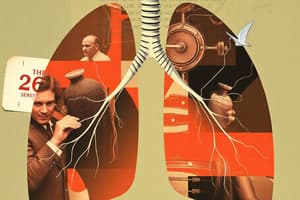Podcast
Questions and Answers
Which of the following occurs during inspiration to create a pressure gradient for air entry into the lungs?
Which of the following occurs during inspiration to create a pressure gradient for air entry into the lungs?
- Decrease in thoracic cavity volume
- Increase in pressure within the lungs
- Expansion of the rib cage (correct)
- Increase in thoracic cavity pressure
During inspiration, which of the following muscles contracts to increase the size of the thoracic cavity?
During inspiration, which of the following muscles contracts to increase the size of the thoracic cavity?
- External intercostal muscles (correct)
- Internal intercostal muscles
- Abdominal muscles
- Pectoral muscles
What is the primary process by which air leaves the lungs during expiration?
What is the primary process by which air leaves the lungs during expiration?
- Passive relaxation of muscles (correct)
- Contraction of the diaphragm
- Active energy expenditure
- Relaxation of the external intercostal muscles
What is the term used to describe normal expiration as compared to forced expiration?
What is the term used to describe normal expiration as compared to forced expiration?
Which muscle plays a crucial role in enlarging the thoracic cavity during inspiration?
Which muscle plays a crucial role in enlarging the thoracic cavity during inspiration?
How does the contraction of the diaphragm contribute to inspiration?
How does the contraction of the diaphragm contribute to inspiration?
What causes the thoracic cavity to return to its original size during normal expiration?
What causes the thoracic cavity to return to its original size during normal expiration?
According to Boyle's Law, what happens to the pressure within the lungs when the volume of the thoracic cavity increases?
According to Boyle's Law, what happens to the pressure within the lungs when the volume of the thoracic cavity increases?
What plays a significant role in driving the movement of air into and out of the lungs?
What plays a significant role in driving the movement of air into and out of the lungs?
Where is the initial increase in pressure measured during inspiratory pressure?
Where is the initial increase in pressure measured during inspiratory pressure?
What can an increase in pleural pressure lead to?
What can an increase in pleural pressure lead to?
Why is understanding the mechanics of breathing essential?
Why is understanding the mechanics of breathing essential?
Study Notes
Understanding the Mechanics of Breathing: Inspiration, Expiration, Lung Volumes, and Pressure Changes
Breathing is a fundamental physiological process essential for life. It involves the intake of oxygen and the release of carbon dioxide through the process of pulmonary ventilation. The mechanics of breathing involve several key aspects: inspiration, expiration, lung volumes, and pressure changes.
Inspiration and Expiration
Inspiration, commonly referred to as inhalation, is the process by which air enters the lungs. During inspiration, the thoracic cavity expands due to the contraction of two primary muscles: the diaphragm and external intercostal muscles. The diaphragm, a large muscle located under the lungs, contracts and moves inferiorly towards the abdominal cavity, increasing the size of the thoracic cavity and allowing more space for the lungs to expand. At the same time, the external intercostal muscles contract, moving the ribs upward and outward, causing the rib cage to expand. This expansion increases the volume of the thoracic cavity, which leads to a decrease in pressure within the lungs, creating a pressure gradient that drives air into the lungs.
Expiration, also known as exhalation, is the process by which air leaves the lungs. Normal expiration is passive, meaning no energy is required to push the air out. Instead, during normal expiration, the elastic recoil of the lung tissue and chest wall causes the thoracic cavity to return to its original size, forcing the lungs to contract and air to exit through the mouth or nose.
Lung Volumes and Pressure Changes
The mechanics of breathing involve changes in lung volumes and pressures. Boyle's Law states that the pressure of a gas is inversely proportional to its volume when temperature remains constant. Therefore, when the volume of the thoracic cavity increases, the volume of the lungs increases, and the pressure within the lungs decreases. Conversely, when the volume of the thoracic cavity decreases, the volume of the lungs decreases, and the pressure within the lungs increases. These changes in pressure drive the movement of air into and out of the lungs.
Pressure relationships play a significant role in the mechanics of breathing. In inspiratory pressure, the initial increase in pressure occurs distal to the expiratory valve, while in expiratory pressure, it is measured proximal to the expiratory valve. Airway pressure is typically displayed in respiratory mechanics studies, and it can be partitioned into resistive and elastic pressure components. An increase in pleural pressure, or intrathoracic pressure, can lead to positive end-expiratory pressure (PEEP), which helps maintain lung volumes and prevents collapse after expiration. However, excessive PEEP levels may cause lung damage.
In conclusion, understanding the mechanics of breathing is essential for appreciating the physiological processes involved in providing oxygen to the body and removing carbon dioxide. The mechanisms of inspiration and expiration depend on lung volumes and pressure changes driven by the action of inspiratory and expiratory muscles, all working together to facilitate efficient breathing.
Studying That Suits You
Use AI to generate personalized quizzes and flashcards to suit your learning preferences.
Description
Test your knowledge on the fundamental physiological process of breathing, covering inspiration, expiration, lung volumes, and pressure changes. Learn about Boyle's Law, pressure relationships, and the roles of inspiratory and expiratory muscles in efficient breathing.




